
Top 25 Rankings 1901-1935
1920 National Championship
Home
1920
College Football Top 25
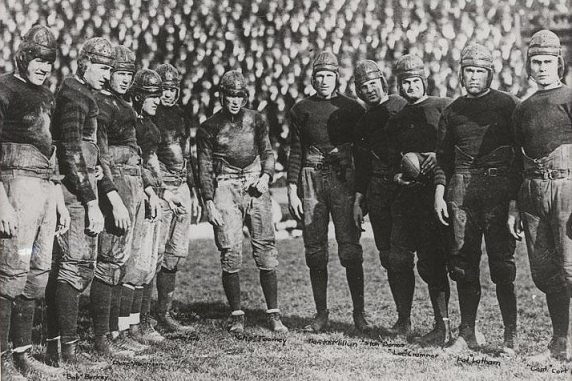
Pictured above is California's 1920 "Wonder Team" at
the Rose Bowl. 9-0 Cal outscored opponents 510-14, and they shocked the
nation by trouncing previously unbeaten and untied Ohio State in the
Rose Bowl 28-0, leaving them the consensus choice as 1920 mythical
national champion (MNC).
The other MNC contenders for 1920 were 8-0-1 Harvard, 6-0-1 Princeton, and 9-0 Notre Dame. I summarized each of
these
teams and compared them in detail in my 1920
national championship article.
As I concluded there, Cal is the only viable choice for an MNC and for
#1. Harvard and Princeton would have been rated next, in that order, and that works fine.
California #1, Harvard #2, and Princeton #3.
#4: Ohio State
7-1
Ohio State would have been rated #1 in an AP poll at the end of the
regular season, and even after their 28-0 loss to 9-0 Cal there, they
would certainly have been ranked higher than 9-0 Notre Dame in a
post-bowl poll. Notre Dame was the Boise State of their time, not yet
respected the way they would be just 4 years later. Ohio State defeated
6-1 Wisconsin (will be ranked #6), 5-2 Michigan (#13), and 5-2 Illinois
(#7), while Notre Dame defeated just 1 top 25 team, 7-2 Army (#18).
Ohio State #4.
#5: Notre
Dame vs. Wisconsin
I suspect that
6-1 Wisconsin would have been rated higher than 9-0 Notre Dame as well,
but this is a close call. Wisconsin also beat just 1 top 25 team, 5-2
Illinois (#7), and while Illinois was a better team than Notre Dame victim Army,
Wisconsin only beat Illinois by 5 at home, while Notre Dame beat Army
by 10 on the road. Notre Dame only had 1 close win, and Wisconsin had
2, one of them over 1-6 Minnesota, and on that basis we're going to
rank Notre Dame higher here.
7-0-2
Penn State and 6-0-2 Pittsburgh likely would have been rated higher
than Notre Dame too, but those teams took upsets, and Notre Dame did
not.
Notre Dame #5, Wisconsin #6.
Wisconsin
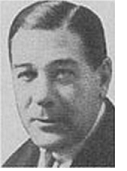 Wisconsin
was coached by alumnus John Richards (pictured). He had gone 23-9-4 at
Colorado College 1905-1909, and then he went 5-1-1 in a one-year stint
at Wisconsin in 1911. They tied mythical national champion Minnesota
that season, but blew an MNC themselves with a 6-0 loss at 6-1 Chicago
in their finale the next week. The next year he went 6-3 at Ohio State,
winning the Ohio Athletic Conference the year before OSU joined the Big
10. He finished up his career back at Wisconsin in 1917 and 1919-1922,
going 24-8-3 in that stint. That made him 29-9-4 in his 6 seasons at
Wisconsin, and 58-21-8 overall.
Wisconsin
was coached by alumnus John Richards (pictured). He had gone 23-9-4 at
Colorado College 1905-1909, and then he went 5-1-1 in a one-year stint
at Wisconsin in 1911. They tied mythical national champion Minnesota
that season, but blew an MNC themselves with a 6-0 loss at 6-1 Chicago
in their finale the next week. The next year he went 6-3 at Ohio State,
winning the Ohio Athletic Conference the year before OSU joined the Big
10. He finished up his career back at Wisconsin in 1917 and 1919-1922,
going 24-8-3 in that stint. That made him 29-9-4 in his 6 seasons at
Wisconsin, and 58-21-8 overall.
Wisconsin had 3 first team All Americans this season:
tackle Ralph Scott (consensus), end Frank Weston (nonconsensus), and
center George Bunge (nonconsensus). Their one loss came 13-7 at Ohio
State, costing them the Big 10 title and costing the Big 10 a lot of
pride when OSU was slaughtered by Cal in the Rose Bowl. Had Wisconsin
beaten Ohio State and won the Big 10, they likely would have declined a
Rose Bowl invite, and they would probably be claiming an MNC today on a
7-0 season.
Wisconsin coach John Richards was very angry at the
way his team was treated on their visit to Ohio State this year, though
what his team endured just sounds typical today. They were insulted by
the crowd, heckled, taunted, that sort of thing. But Richards said he
would resign if OSU was put on the schedule again, and the teams would
not play again until 1930.
Penn State, Pittsburgh, Georgia Tech, and Illinois
I think that the next teams to be rated in a 1920 AP poll would have been the following, in this order: 7-0-2 Penn State, 6-0-2 Pittsburgh, 8-1 Georgia Tech, and 5-2 Illinois. This is a group of recent MNC winners: Georgia Tech in 1917, Pitt in 1918, and Penn State and Illinois splitting the 1919 MNC.
Georgia Tech's only loss came to Pittsburgh, and I could see rating
Illinois behind Tech if I didn't look at the teams ahead of Tech. But I
did look at those teams, and I can't see why Illinois should be rated
behind Penn State and Pittsburgh. Penn State and Pitt tied each other
at season's end, and 7-0-2 Penn State took their other tie to 5-2-2
Lehigh (not close to rated) the game before that. PSU played a fairly
tough schedule, but they only actually defeated 1 rated team, 7-2
Dartmouth (will be rated #14). At 5-2, Illinois had a worse straight
record, but they had a better relevant record
because they did not take a loss or tie to a lower-rated team. Their
losses came by 5 points at #6 Wisconsin and by 7 to #4 Ohio State. They
defeated 5-2 Michigan (#13).
Pitt also took an upset tie, at
6-2-1 Syracuse (#19), and they also beat just 1 top 25 team (the
aforementioned Georgia Tech). So like Penn State, Pitt should be rated
behind Illinois, who took no upsets. PSU being rated ahead of Pitt
works fine due to performance: PSU only had 1 close win, while Pitt had 3, 2 of them over "unrated" opponents. PSU beat 6-4 Penn 28-7, Pitt beat them 27-21.
Illinois #7, Penn State #8, Pittsburgh #9, and Georgia Tech #10.
Boston College, Centre, and Michigan
These are the teams I think would have come next in a 1920 AP poll, and this order works fine:
8-0 Boston College, 8-2 Centre, and 5-2 Michigan. BC was a mid-major
that mostly played minor or other mid-major teams, but they pulled off
a big 21-13 win at 5-3 Yale (will be ranked #16). They won all of their
games by more than a touchdown, and could viably be ranked higher than
this.
8-2 Centre took their losses to #2 Harvard and #10 Georgia
Tech. They destroyed the other 8 teams on their schedule, scoring more
than 100 points twice and winning 63-7 at 9-1 Texas Christian (average
score in their wins 65-1!). But they didn't come close in either of
their losses, and they did not actually defeat a top 25 team.
5-2
Michigan took their losses to #4 Ohio State and #7 Illinois. Those
losses were both close, but Michigan did not beat a top 25 team, and
they struggled to top 1-6 Minnesota 3-0.
Boston College #11, Centre #12, and Michigan #13.
Boston College

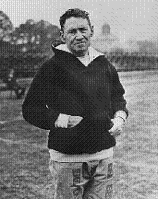
Boston
College would not move up to being fully considered a major team until
the latter half of the 1930s. They started winning as a minor team in
1916, and they made an even bigger splash under Hall of Fame coach
Frank Cavanaugh (pictured above at right), who went 48-14-5 there
1919-1926. This was by far his best season. He was a Dartmouth grad who
had gone 42-9-3 at his alma mater 1911-1916, and after leaving Boston
College he built Fordham up into a major player in the college football
world, going 34-14-4 there 1927-1932. Overall he was 145-48-17 at 5
schools.
On the field, BC was led by consensus All American end Lake Urban.
Dartmouth, VMI, and Yale
And here's the next group of teams I think a 1920 AP poll would have rated, and again this order works fine: 7-2 Dartmouth, 9-0 Virginia Military Institute, and 5-3 Yale.
7-2 Dartmouth took their losses to #8 Penn State (by 7) and 6-2-1
Syracuse (will be rated #19). They won all the rest of their games by
more than a touchdown, including 27-14 over 5-3 Holy Cross (#22), 14-3
over Cornell, 44-7 at 6-4 Penn, and 14-6 over 6-3 Brown (no 2-point
conversion back then). Dartmouth took an upset loss, and obviously 9-0
VMI did not, but the team that upset them, Syracuse, was top 25 caliber, and VMI did not play any
top 25 teams, so VMI can be rated lower than Dartmouth.
VMI was
very impressive though. I would rate them in the top 10, but they were
virtually ignored by the national media this season, and their schedule
makes this low a rating viable. They scored 136 on a minor team, and
they won 22-6 at 5-2-2 Virginia, 27-7 at 6-4 Penn, and 14-0 over 7-3
North Carolina State. They won every game by more than a touchdown, 14
points being the closest anyone got to them.
5-3 Yale took their losses to #2 Harvard, #3 Princeton, and #11
Boston College, and all 3 of those teams were unbeaten this season, so
for all we know Yale was a top 10 team. But they did not come within a
touchdown of any of those teams, and they did not beat a top 25
opponent. Their best win was 14-10 over 6-3 Brown (#26-38), not very
impressive.
Dartmouth #14, Virginia Military Institute #15, and Yale #16.
Virginia Military Institute
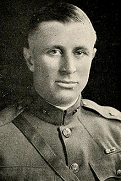
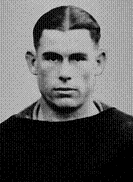
This
is the only season VMI ever legitimately fielded a top 25 team. They
went 9-0-1 and were rated #20 in the 1957 AP poll, but I tossed them
out when I fixed it. The 1920 team,
however, was legit. The coach was Blandy Clarkson (pictured above at
left), who went 44-21-2 there 1920-1926, then served as athletic
director 1926-1946. The star player was halfback Jimmy Leech (pictured
above at right), who led the nation with 210 points, a big chunk of
that coming from 26 touchdowns. He is in the Hall of Fame.
Navy, Army, and Syracuse
Our next group of teams, again in the order I think a 1920 AP poll would have ranked them: 6-2 Navy, 7-2 Army, and 6-2-1 Syracuse.
6-2 Navy lost to #3 Princeton, and they took an upset loss to 7-3
North Carolina State (not top 25, or even quite close, though a good
team), but they beat Army 7-0 in their finale to get this spot in the
top 25. 7-2 Army took their other loss to #5 Notre Dame, but their 7
wins all came over minor teams and were absolutely worthless. They were
"impressive" in those games though.
6-2-1 Syracuse was erratic and difficult to rate. They tied #9
Pittsburgh and defeated #14 Dartmouth, but they lost to 5-3 Holy Cross
(will be #22) and 7-2 Maryland (#26-38). I would rate Syracuse higher
than this, but Army had the better relevant record by an effective half
a game, so I'll leave them here.
Navy #17, Army #18, and Syracuse #19.
Texas and Georgia
9-0 Texas is the
5th team with a perfect record to make this top 25, but they get a
token spot down here because they didn't beat anyone that raised
eyebrows (Boston College beat Yale and VMI beat Penn, considered power
teams of the time). Texas won the SWC with a 7-3 victory over 6-1-1
Texas A&M (not top 40) in their finale. Of course, BC and VMI won
every game by more than a touchdown.
8-0-1 Georgia missed out on perfection with a tie at 5-2-2
Virginia (will be rated #26-38). They brought home several big wins,
though: 7-0 at 9-1 Furman
(#26-38), 7-0 over 7-2 Auburn (#24), and 21-14 over 10-1 Alabama (#25).
I would rank them higher than Texas, but I suspect an AP poll would not
have, and Georgia did take an upset tie, so Texas will get the nod here.
Texas #20, Georgia #21.
Texas
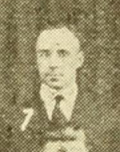
Texas
was helmed by Berry Whitaker (pictured), who had a short but fantastic
career as a head coach, 22-3-1 here 1920-1922. He then abruptly
retired, citing too much pressure (ulcers and such), which is a
familiar refrain from Texas coaches throughout history. His
predecessor, Bill
Juneau, had gone 19-7 over 3 years, including 9-0 in 1918, but he
resigned because he couldn't take the constant criticism of the fans.
His predecessor, Dave Allerdice, went 33-7 over 5 years and won a pair
of conference titles, and he resigned for the exact same reason. And
years later, Blair Cherry had another short but terrific stint at
Texas, going
32-10-1 1947-1950, and he too resigned early, citing similar reasons as
Whitaker, Juneau, and Allerdice.
Whitaker had first been hired in 1916 to
create and run the Texas intramural sports program, and he happily
returned to that pressure-free post and presided over Texas intramurals
for 40 years.
Washington State, Auburn, Alabama, Chicago, and Holy Cross
Next up in a 1920 AP poll would likely have been these teams, in order:
5-1 Washington State, 7-2 Auburn, 10-1 Alabama, and 3-4 Chicago.
Chicago obviously had a losing record, but their losses came to #4 Ohio
State, #6 Wisconsin, #7 Illinois, and #13 Michigan, by a total of 21
points, and they defeated 5-2 Iowa (#26-38) 10-0. They were probably
top 25 worthy, possibly as strong as #14, but I prefer not to rate
losing teams when there's another viable option. And this season there
is another viable option: 5-3 Holy Cross.
Holy Cross took their losses to #2 Harvard, #11 Boston College, and
#14 Dartmouth, and they got a big upset win 3-0 at home over #19
Syracuse. That's the only win of value they had, but Chicago only had
one as well, and not over a higher-rated team. In fact, with an upset
win, Holy Cross had a better relevant record than did Washington State,
Auburn, and Alabama as well. So we'll move them ahead of all these
teams. #21 Georgia can remain ranked ahead of Holy Cross because they
beat 2 rated teams and a 3rd who is close.
5-1 Washington State
took their loss 49-0 to #1 California. They struggled to get by a weak
Idaho team 14-7, but they got some national attention by traveling
halfway across the country to beat 5-3-1 Nebraska (#26-38) 21-20 in
Lincoln in their finale. They were coached by Gus Welch, Hall of Fame quarterback for Carlisle's 1911 MNC team.
7-2 Auburn gets the nod over 10-1
Alabama because at this time, Auburn had far greater name value.
Alabama was a team on the rise, though. Auburn's losses came to #10
Georgia Tech and #21 Georgia, and Alabama lost to #21 Georgia as well.
The main difference between them, other than name value at this time in
history, was that Auburn beat 5-3-1 Vanderbilt (#26-38) 56-6, and
Alabama beat the same team just 14-7. None of Auburn's wins was close.
Holy Cross #22, Washington State #23, Auburn #24, and Alabama #25. Chicago doesn't quite make it.
Holy Cross
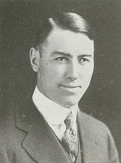
Holy
Cross was a mid-major team coached by alumnus Cleo O'Donnell
(pictured), who went 69-27-6 there 1919-1930, and never had a losing
season. He had played at Holy Cross for Hall of Fame coach Frank
Cavanaugh, who was this season coaching at bitter rival Boston College.
O'Donnell went 102-46-9 overall at 3 schools. In 1929 he became Holy
Cross' first full-time athletic director. He hired Hall of Fame coach
Eddie Anderson in 1933, and Anderson took Holy Cross to big-time
football success and a few AP poll finishes. He was playing for Notre
Dame's 9-0 team this season.
Others
Receiving Votes
Here
are the teams closest to making this top 25, a much bigger group than
usual this time around. And there were plenty of other good teams that
didn't even quite make the list below:
7-1 Missouri, 10-0-1 Tulsa, 6-1-1 Texas A&M, 6-1 Pomona, 6-2
Cornell, 7-3 North Carolina State, 6-4 Georgetown, and 5-3 Lafayette. A
very deep year for good college football teams.
Chicago 3-4
As stated above, 3-4 Chicago lost "to #4 Ohio
State, #6 Wisconsin, #7 Illinois, and #13 Michigan, by a total of 21
points, and they defeated 5-2 Iowa (#26-38) 10-0. They were probably
top 25 worthy, possibly as strong as #14, but I prefer not to rate losing teams when there's another viable option. And this season there is another viable option: 5-3 Holy Cross."
Iowa 5-2
5-2 Iowa took
their losses to #7 Illinois and to Chicago. They won 14-7 at 5-2
Indiana (also on this list), but struggled to beat 4-4 Iowa State 14-10
in their finale, and neither of their losses was close.
Maryland 7-2
7-2 Maryland
lost 35-0 to #3 Princeton, and they took an upset loss 6-0 at 2-7
Rutgers, but they got an upset win 10-7 at #19 Syracuse. Beyond that
one big win, they were unimpressive.
Brown 6-3
6-3 Brown took
their losses to #2 Harvard, #14 Dartmouth, and #16 Yale. Their wins all
came by more than a touchdown, but those teams were very poor and held
no value.
Furman 9-1
9-1 Furman's loss came 7-0 to #21 Georgia. The rest of their schedule held no value, and they struggled to beat Davidson 7-0.
Texas Christian 9-1
Texas Christian
went 9-0 against an incredible weak schedule in the regular season,
squeezing past rubes like Austin 9-7, Phillips 3-0, and Southwestern
(Texas) 21-16. So it was not terribly surprising when #12 Centre
curb-stomped them 63-7 in the "Fort Worth Classic" on January 1st. TCU
was probably not even worthy of making this list, but hey, they took no
upset losses, so who knows?
Vanderbilt 5-3-1
5-3-1 Vanderbilt
took their losses to #10 Georgia Tech (44-0), #24 Auburn (56-6), and
#25 Alabama (14-7), and they tied 5-2-2 Virginia (covered next). Two of
those losses were quite ugly, but all of Vanderbilt's wins came by more
than a touchdown (average score in those games 30-1).
Virginia 5-2-2
5-2-2
Virginia took their losses to #2 Harvard and #15 VMI, and they tied #21
Georgia and 5-3-1 Vanderbilt (covered above). They had no wins of
value. The tie with Georgia would place them higher than Vanderbilt,
but the tie with Vandy knocks them out of the top 25.
Pennsylvania 6-4
6-4
Penn took their losses to #15 VMI, #8 Penn State, #9 Pitt, and #14
Dartmouth. They beat 5-3 Lafayette and 6-2 Cornell, and may well have
been a top 25 team power-wise. On the other hand, 3 of their losses
were ugly, and they had 2 close wins over weak opponents.
Indiana 5-2
5-2
Indiana took their losses to #5 Notre Dame and to 5-2 Iowa (covered
above). Their loss to Notre Dame was by just 3 points, their best
result of the season. They struggled to get by 3-4 Northwestern and 2-5
Purdue, but they beat 5-3 Mississippi State 24-0.
Southern Cal 6-0
6-0
Southern Cal beat 6-1 Pomona 7-0, but we know little to nothing about
either team. Maybe USC was a top 25 team power-wise. Maybe they weren't
even top 40. We'll never know. But they were on the verge of big time
football success, and would first make a name for themselves with a
Rose Bowl win over Penn State following the 1922 season.
Oklahoma 6-0-1
6-0-1
Oklahoma took an upset tie at 3-3-3 Kansas State. All of their wins
came by more than a touchdown, including 28-7 at 7-1 Missouri and 21-9
over 5-2-1 Kansas.
Nebraska 5-3-1
5-3-1
Nebraska took their losses to #5 Notre Dame, #8 Penn State, and #23
Washington State, and they took an upset tie at 5-2-1 Kansas. They beat
6-1-1 Colorado State 7-0, and went to New York City to crush 2-7
Rutgers 28-0.
1920
Top 25
1) California 9-0
2) Harvard 8-0-1
3) Princeton 6-0-1
4) Ohio State 7-1
5) Notre Dame 9-0
6) Wisconsin 6-1
7) Illinois 5-2
8) Penn State 7-0-2
9) Pittsburgh 6-0-2
10) Georgia Tech 8-1
11)
Boston College 8-0
12) Centre 8-2
13) Michigan 5-2
14) Dartmouth 7-2
15) Virginia Military Institute 9-0
16) Yale 5-3
17) Navy 6-2
18) Army 7-2
19) Syracuse 6-2-1
20) Texas 9-0
21) Georgia 8-0-1
22) Holy Cross 5-3
23) Washington State 5-1
24) Auburn 7-2
25) Alabama 10-1
Others
Receiving Votes:
Chicago 3-4
Iowa 5-2
Maryland 7-2
Brown 6-3
Furman 9-1
Texas Christian 9-1
Vanderbilt 5-3-1
Virginia 5-2-2
Pennsylvania 6-4
Indiana 5-2
Southern Cal 6-0
Oklahoma 6-0-1
Nebraska 5-3-1
 Wisconsin
was coached by alumnus John Richards (pictured). He had gone 23-9-4 at
Colorado College 1905-1909, and then he went 5-1-1 in a one-year stint
at Wisconsin in 1911. They tied mythical national champion Minnesota
that season, but blew an MNC themselves with a 6-0 loss at 6-1 Chicago
in their finale the next week. The next year he went 6-3 at Ohio State,
winning the Ohio Athletic Conference the year before OSU joined the Big
10. He finished up his career back at Wisconsin in 1917 and 1919-1922,
going 24-8-3 in that stint. That made him 29-9-4 in his 6 seasons at
Wisconsin, and 58-21-8 overall.
Wisconsin
was coached by alumnus John Richards (pictured). He had gone 23-9-4 at
Colorado College 1905-1909, and then he went 5-1-1 in a one-year stint
at Wisconsin in 1911. They tied mythical national champion Minnesota
that season, but blew an MNC themselves with a 6-0 loss at 6-1 Chicago
in their finale the next week. The next year he went 6-3 at Ohio State,
winning the Ohio Athletic Conference the year before OSU joined the Big
10. He finished up his career back at Wisconsin in 1917 and 1919-1922,
going 24-8-3 in that stint. That made him 29-9-4 in his 6 seasons at
Wisconsin, and 58-21-8 overall.






